Shoulder Impingement
Table of Contents
What Is Shoulder Impingement?
Shoulder impingement syndrome develops when there is a narrowing of the subacromial space in the joint. Shoulder impingement syndrome happens at the top of the shoulder joint.
Shoulder impingement occurs when the top and outer edge of your shoulder blade, called the acromion when rubs against (“impinges on”) or pinches your rotator cuff under it, causing pain and irritation.
Shoulder impingement syndrome is the most common cause of pain in the shoulder. It is also called impingement syndrome or swimmer’s shoulder since it’s common in swimmers who use the shoulder repetitively. It’s also common in other athletes who use their shoulders in excesses, such as baseball or softball players.
Shoulder impingement syndrome implicates tendonitis (inflammation of tendons) of the rotator cuff muscles as they pass through the subacromial space, the passage under the acromion. It is especially associated with tendonitis of the supraspinatus muscle. Tendonitis can result in pain, weakness, and loss of shoulder movement.
A rotator cuff is a set of muscles and tendons that connect the upper arm bone(humerus) to the shoulder(scapula). They help to raise and rotate the arm. The rotator cuff present under the top of the shoulder is called the acromion. If a person has shoulder impingement, the rotator cuff hooks or rubs against the acromion. When a person lifts the arm, the space (bursa) between the rotator cuff and acromion narrows, which increases pressure on it. The high pressure irritates the rotator cuff, leading to impingement.
When the muscles and tendons don’t slide easily and typically, the tendons and bursa (a fluid-filled sac that protects the tendons and prevents friction between them) become irritated and swollen causing pain.
It happens when there is an impingement of tendons or bursa in the shoulder from the bones of the shoulder. It appears when there is that overhead activity of the shoulder, especially repeated activity, and it is a risk factor for shoulder impingement syndrome. For example, work includes painting, lifting, swimming, tennis, and other overhead sports. Other risk factors involve bone and joint abnormalities.
With impingement syndrome, pain is constant and affects day-to-day activities. Movements such as touching behind the back or reaching up overhead to put on a coat or blouse may cause pain.
Over a long time, impingement syndrome can lead to inflammation of the tendons of the rotator cuff muscle called tendonitis, and bursa called bursitis. If it is not treated properly, the rotator cuff tendons can start to become thin and can tear easily.
Anatomy of the shoulder joint:
The shoulder joint is formed up of three bones:
- Humerus: upper arm bone
- Scapula: shoulder blade
- Clavicle: collar bone
The bones in the shoulder are connected together by ligaments, and one of them is the coracoacromial ligament, which connects the acromion process and the coracoid process, bony projections off the scapula.
The acromion and the coracoacromial ligament develop a sort of bridge or roof over the top of the shoulder called as the coracoacromial arch. The space below this arch is known as the subacromial space.
Each of the rotator cuff muscle tendons runs through the subacromial space and as the arm moves up and down, the rotator cuff tendons slide backward and forward through this space.
Between the subacromial space and the rotator cuff tendons are the subacromial bursa, which is a small fluid-filled sac that protects the tendons and prevents friction against the bone.
The space underneath the acromion is relatively small, and the gap gets narrower as you raise your arm up because of how the bones and tendons move.
Shoulder impingement syndrome refers to a number of problems that can develop in this area, the common factor being that the subacromial space narrows more than normal leading to pinching or friction on the soft tissues.
Mechanism of shoulder Impingement:
When the rotator cuff is irritated or injured, it swells in much the same way as the ankle does when it is sprained. However, because the rotator cuff is covered by bone, swelling causes other circumstances to occur. Swelling decreases the amount of space around the rotator cuff, leading to rubbing against the acromion. Like a vicious cycle, the rubbing of the rotator cuff tendons results in swelling, which further narrows the space below the acromion. In some cases, bone spurs develop on the acromion bone and can contribute to impingement by causing the space where the rotator cuff sits to be even more narrow.
Causes of Shoulder impingement syndrome:
The rotator cuff tendon passes through a space below the acromion called subacromial space. The acromion is the bony tip of the outer edge of the shoulder blade (scapula) that comes off the top of the back side of this bone. It meets with the end of the collarbone (clavicle) at the shoulder. Shoulder impingement occurs when the tendon rubs against the acromion process.
Shoulder impingement syndrome commonly affects people who engage in activities that require repetitive overhead upper limb movements or heavy liftings such as swimming, throwing, weightlifting, and racket sports, or occupations such as building, decorating, and electrical work. It is also often associated with aging, as age increases degeneration occurs.
The common causes of subacromial impingement are divided into two categories:
- Primary Shoulder Impingement:
From bony abnormalities. It occurs when there are changes in the shape or angle of the acromion that decrease the size of the subacromial space from wear and tear or a congenital abnormality - Secondary Shoulder Impingement:
- From dynamic instability. A combination of weakness and/or tightness in the shoulder muscles alters the position of the acromion, decreasing the subacromial space. This leads to repetitive friction on the soft tissues which in turn leads to inflammation.
Impingement symptoms can happen when there is compression and microtrauma which harm the tendons. There are several causes of shoulder impingement syndrome involving:
- Repetitive overhead movements, such as Golfing, Throwing, Racquet Sports, and Swimming, or Frequent overhead reaching or lifting activities.
- Injury, such as a fall on an outstretched hand, where the shoulder gets compressed.
- Bony abnormalities of the acromion process, narrow the subacromial space.
- Osteoarthritis in the shoulder region.
- Poor strength of rotator cuff and shoulder blade muscle, causing the humeral head to move abnormally.
- Thickening of the bursa present in the joint.
- Thickening of the ligaments around the shoulder area.
- The tightness of the soft tissue around the shoulder joint is known as the joint capsule.
Over a long time, such activity that repeatedly requires a person to move the arm high above the shoulder level and toward the back may put the shoulder at risk of impingement. Examples of these activities include:
- Swimming
- Tennis
- Softball
- Baseball
- Painting
- Packing object
- Lifting heavy object
- Construction
- Shoulder impingement occurs due to overuse of shoulder movement, but age is also a factor. The longer the person uses the shoulder or does these types of activities regularly, the more likely symptoms become to start.
Injuries, including a dislocated shoulder, are the other most important causes of shoulder problems, including impingement and rotator cuff tears.
These different causes of shoulder impingement syndrome in some more detail:
X-ray shows subacromial calcium deposits, which decrease the subacromial space, increasing the risk of shoulder impingement syndrome
- Degeneration
A common reason for primary shoulder impingement syndrome is wear and tear of the acromion process in which there is degeneration that results in bone spurs. Rather than the acromion being smooth, small extra growths of bone stick out and rub on the rotator cuff tendons, leading to shoulder impingement syndrome. This degeneration may occur through repetitive movements or due to the normal aging process. - Congenital Abnormalities
Any other common reason for primary shoulder impingement syndrome is a Congenital Abnormality – i.e. injury present from birth. In some people, the acromion forms at a slightly different angle compared to normal that affecting the shape of the acromial arch which can decrease the space in the subacromial space. This also boosts the friction on the rotator cuff tendons leading to shoulder impingement syndrome. - Shoulder Tendonitis
Supraspinatus tendonitis is a common cause of pain in the shoulder called impingement syndrome. The tendon glides through the subacromial space, making the tendon prone to excessive friction which results in inflammation.
One of the most typical causes of secondary shoulder impingement syndrome is tendonitis, where repetitive friction on the rotator cuff tendon and biceps tendons leads to inflammation. Due to swelling, there is a decrease in the subacromial space and as pressure increases on the tendon, it reduces the blood flow causing further damage to the tendon. The rotator cuff tendons most typically affected by subacromial impingement are supraspinatus and long head of biceps as they run directly through the subacromial space. Inflammation in these tendons is called supraspinatus tendonitis or painful arc syndrome and biceps tendonitis. Tendonitis can occur from a shoulder injury, repetitive movements, or overuse of the shoulder. In a few cases, there is the deposition of calcium in the tendon. If it is left untreated, the tendon may even get torn.
- Shoulder Bursitis
Another common reason for secondary shoulder impingement syndrome is bursitis. More friction on the subacromial bursa leads to inflammation of the bursa which is a small fluid-filled sac, called subacromial bursitis. Again, this diminishes the subacromial space leading to shoulder impingement syndrome.
Risk factors:
Playing sports that require using the repeated use of shoulders for overhead or forceful motion is the biggest risk factor for developing shoulder impingement syndrome. Common activities that could cause shoulder impingement to include:
- Swimming
- Tennis
- Baseball
Occupations that require lots of heavy lifting or arm movement also increase the risk of the condition. These occupations include:
- Construction work
- Moving Boxes
- Painting
Other risk factors:
- Old age: Age more than 50 years have a risk of shoulder impingement syndrome.
- Previous shoulder injuries: Previous injuries such as a shoulder dislocation are also risk factors for shoulder impingement. Some people also have an unusually shaped that is an abnormal shape of acromion that increases their risk.
Signs and symptoms of Shoulder impingement syndrome:
Symptoms start off somewhat mild but get gradually worse as the condition progresses. Symptoms of shoulder impingement syndrome include:
- Minor but constant pain in the arm
- Arm weakness
- Shoulder joint Stiffness
- Tenderness
- Swelling
- Unable to move shoulder full range
- Can not able to sleep on the affected side
- Loss of movement on the affected shoulder
- Pain and tenderness in the anterior side of the shoulder.
- Pain when the arms are lengthened above the head.
- Pain occurs when lifting the arm, lowering the arm from a raised position, or when reaching for something overhead.
- Pain while moving from the front of the shoulder to the side of the arm.
- Pain when lying on the affected side of the body.
- Pain or achiness at night affects the ability to sleep.
- Pain when reaching behind the back, like reaching into a back pocket of jeans or zipping up a zipper.
- Shoulder and/or arm weakness and stiffness.
- Pain while lifting a more heavy object
Symptoms usually develop gradually over a few weeks to months.
Shoulder impingement is closely linked to other common sources of pain in the shoulder called bursitis and rotator cuff tendonitis. These conditions can occur alone or in combination with shoulder impingement conditions. Shoulder pain can also be a sign of a more serious injury to the rotator cuff, a small tear or hole called a rotator cuff tear. If the rotator cuff has torn completely, you will likely have significant weakness in the shoulder and may not be able to raise the arm against gravity. In addition, a person may have a rupture (tear) of the biceps muscle tendon as part of this continuing impingement process.
Diagnosis:
The doctor will ask about medical history, and drug history and perform a physical examination to check for pain and tenderness. The doctor will also assess the range of motion of the shoulder and arm/shoulder strength. The doctor will ask about occupation if you are involved in repetitive activities that require overhead arm movement. Also ask about what medicines and remedies you have tried to relieve your pain, prior injuries to the affected arm/shoulder, and any details about what may have caused your shoulder pain and when it began.
The doctor will diagnose the condition by imaging method and also by clinical tests:
- X-ray: X-rays are helpful to rule out arthritis and also may show rotator cuff injury. The X-ray may show the presence of bone spurs or changes in the normal outline of the bone where the rotator cuff normally attaches.
- Magnetic resonance imaging (MRI ): MRI shows subacromial impingement with partial rupture of the supraspinatus tendon, but no retraction or fatty degeneration of the supraspinatus muscle.
- Ultrasound: Ultrasound shows injury in the soft tissues, can show tears in the rotator cuff tendons, and inflammation in the bursa.
A person will complain about pain in the shoulder while moving the shoulder overhead.
Pain due to repetitive activities. The patient may have pain on the affected side. Also, the pain will increase at night, due to pain there is a disturbance in sleep.
Onset is usually slow or insidious, typically developing over weeks to months, and patients are often unable to describe a direct trauma or inciting event that resulted in the pain. Pain is generally described as being located over the lateral acromion, frequently with radiation to the lateral mid-humerus.
Special attention should be made to the clinician to inquire about overhead activities and repetitive activities. Relief may be recorded with rest, anti-inflammatory medications, and ice, but symptoms often reoccur upon return to activity.
A diagnosis of impingement syndrome may be made by painkiller medicine. If a small amount of an anesthetic (painkiller), is injected into the space under the acromion, it will relieve the pain.
Physical examination includes inspection, palpation, passive, and active range of motion, and strength testing of the neck and shoulder, all of which are compared bilaterally. Often, patients may have weakness in the abduction and/or external rotation of the affected side. Scapular dyskinesis can be noticed with a forward elevation of the arm.
Tenderness on palpation is usually present over the coracoid processor scapula of the affected arm.
- Special tests are essential components of the physical examination. Those tests are specific to shoulder impingement syndrome. These include the Hawkins test, Neer sign, Jobe test, and a painful arc of motion. Individually, these tests have low sensitivity and specificity, but when these all tests are performed combined, they can help diagnose shoulder impingement syndrome.
- Hawkin’s Kennedy test: This test is executed when the patient’s arm is positioned passively internally rotated with the shoulder in 90 degrees of shoulder forward flexion and elbow flexion. Pain over the acromion process suggests subacromial impingement but may be negative in internal impingement.
- Neer’s sign: The patient is positioned with the scapula fixed into a depressed position, The examiner performed the test by maximally forward flexing the patient’s arm (passive range of motion testing). The test is considered positive. Pain on the anterior side of the shoulder suggests subacromial impingement, whereas pain on the posterior shoulder suggests internal impingement.
- Jobe test: This test is also known as the empty can test, This test is performed by positioning the patient’s arms at 90 degrees of abduction within the scapular plane with maximal internal rotation of the arms, and resisting further abduction by the patient. A test is considered positive if pain occurs n the affected arm.
- Painful arc of motion: The painful arc is a physical finding in which pain occurred with the abduction of the arm between 70 and 120 degrees and forced overhead movement.
Special tests are used to evaluate for shoulder instability including the sulcus sign, anterior apprehension, and relocation. Classically, these tests are negative for shoulder impingement syndrome.
- Sulcus sign: The patient sitting in an upright position with the arm resting at their side. The clinician stabilizes the shoulder proximally and applies pressure inferiorly directed at the elbow. A positive test is documented based on the inferior displacement of the humeral head.
- Anterior apprehension test: The patient lying in the supine position, this test is performed by positioning the patient’s shoulder in 90 degrees of abduction and 90 degrees of external rotation. While holding the proximal shoulder, the clinician applies greater gentle external rotation movement. The test is considered positive if the patient reports a subjective feeling of impending subluxation or near dislocation.
- Relocation test: The relocation test is for shoulder instability and it requires a positive anterior apprehension test. After the patient complains of the prodrome of dislocation or subluxation described above. The clinician applies a force in the posterior direction on the anterior humeral head, which relieves the patient’s symptoms.
Treatment of Shoulder impingement syndrome:
Treatment of impingement syndrome can vary from simple home treatment such as aspirin and rest to surgery, depending on how severe your impingement is.
Conservative treatments are effective for many people to relieve pain. 55- 60% of cases respond sufficiently to conservative treatment within 2 years. Minor cases may settle more quickly.
Conservative treatment for shoulder impingement:
- Rest
- Medication including nonsteroidal anti-inflammatory drugs (NSAIDs)
- Heat
- Physical therapy
- Elastic therapeutic tape
Physical therapy includes gentle exercises to strengthen the muscles in the shoulder and restore the range of motion in the shoulder
Home treatment:
Use of RICE Principle:
REST: Rest is very crucial when it comes to treating shoulder impingement. Avoid any laborious exercise or any movements that make the pain worsen. This is especially important if a person is an athlete.
While it’s good to not move the shoulder too much, avoid using a sling to immobilize the arm completely. Immobilization can lead to more weakness and stiffness in the shoulder.
Ice Therapy: Using an ice pack regularly for 10-15 minutes at a time can help reduce pain and inflammation. Ice packs should be wrapped in a towel and placed over the shoulder for 10 minutes, three to four times daily. To reduce pain and any swelling around the shoulder a patient might have.
Compression: To reduce swelling and pain
Elevation: To reduce swelling in the shoulder.
Medical Treatment:
The doctor will advise nonsteroidal anti-inflammatory drugs, such as ibuprofen. These medicines can help reduce swelling and shoulder pain. If these medications taken along with ice and rest, don’t reduce the pain, a doctor might prescribe steroid injections to reduce swelling and pain.
Injections: Corticosteroid injections may help to decrease inflammation in the tendons or bursa. A mixture of steroids and local anesthetic is injected or infiltrated into the area. Care is needed after taking the injection. Initially, the injection temporarily weakens the tendon increasing the risk of rupture.
Injections should not be used as a stand-alone treatment, they should be followed by a course of physical therapy to ensure the problem does not return.
Surgical treatment:
Surgery For Impingement Syndrome
In some cases of shoulder impingement syndrome, such as if there are bony spurs or if another treatment has failed, subacromial decompression surgery will be advised. The goal of surgery is to increase the subacromial space to make more space for the rotator cuff tendons.
Subacromial decompression surgery for shoulder impingement syndrome is generally carried out arthroscopically. Arthroscope surgery is in which two or three small holes are made around the shoulder. A camera is entered through the hole to allow the surgeon to see the structures via a video screen and small surgical instruments are inserted into the shoulder joint.
In most cases, the surgeon will do surgery to remove part of the acromion bone and sometimes part of the subacromial bursa. This is known as subacromial decompression or acromioplasty. If they find any other issues such as arthritis or a rotator cuff tear, or inflammation of the biceps tendon, they will identify those as well.
After surgery, the doctor may be given a sling to wear initially. A physical therapist plans a rehab program to regain full strength, motion, and stability in the shoulder. It generally takes around 3-5 months to get recovery from shoulder impingement surgery.
Physical therapy:
Shoulder impingement is usually treated sufficiently with physical therapy, which uses gentle exercises to increase strength and increase range of motion. Doctors can refer a patient to a physical therapist who specializes in shoulder injuries.
A physical therapist will first assess the patient’s shoulder to identify any areas of weakness, tightness, stiffness, and instability that have caused the shoulder impingement syndrome and work on a rehab program with you. They may also do some manual therapy to restore motion and positioning at the shoulder, and ultrasound to reduce inflammation and pain
Physical therapy sessions will likely focus on the muscles in the shoulder, arm, and chest, which can help to improve the function of the rotator cuff. If a patient is an athlete or works in a field that requires frequent use of the shoulder, a physical therapist can teach you proper techniques to reduce the chance of recurrence.
The therapist may also teach you some exercises that you can do at home, which may help you recover faster. Just make sure don’t overdo exercise.
- Use of Modalities
Providing adjunct therapies that promote pain relief, reduce inflammation, and increase relaxation and circulation can help treat shoulder pain. A physical therapist can select what treatment will best suit you. If patients have good results in the clinic, a lot of exercises can then be done at home as well.
Ice and heat
A physical therapist will advise you to determine how long, the exact placement, and how often you should apply ice and/or heat to the shoulder.
Ultrasound
This is generally an in-clinic option only that can be used for the first several weeks to kickstart the healing process. Ultrasound is an excellent option for a localized and very specific source of pain, such as rotator cuff tendinitis or bursitis.
Light therapy
Low-level laser therapy, or LLLT, is another modality given in-clinic. This therapy utilizes specific light wavelengths to optimize healing.
TENS unit
A TENS unit can be used in the PT clinic to help relieve pain and improve tolerance for the rest of the treatment session. A Physiotherapist will show you where to put the pads for maximal comfort. If a person is getting good results, they can then recommend what options are best for the patient.
Exercises:
Exercise includes Strengthening of shoulder muscle, stretching of muscle surrounding the shoulder, and stability exercises for shoulder impingement syndrome are the best place to start. With the help of exercises, there is an increase in the subacromial space which takes the pressure and friction off the irritated tendons.
- ROM exercises: Shoulder joint movement
- Shoulder flexion
- shoulder extension
- Shoulder abduction
- Shoulder adduction
- Shoulder external and internal rotation
Begin exercise actively in the available range. Later on, followed by passive movement in full range slowly. For achieving full range, stretching exercises are necessary. As the full range is achieved, strengthening can be achieved.
2. Stretching exercises:
Pendulum exercises:
Cross arm stretch
- Relax both shoulders and gently pull one arm across the chest as far as possible, holding at the upper arm.
- Hold the stretch position for 30 seconds and then relax for 30 seconds.
- Repeat with the other arm.
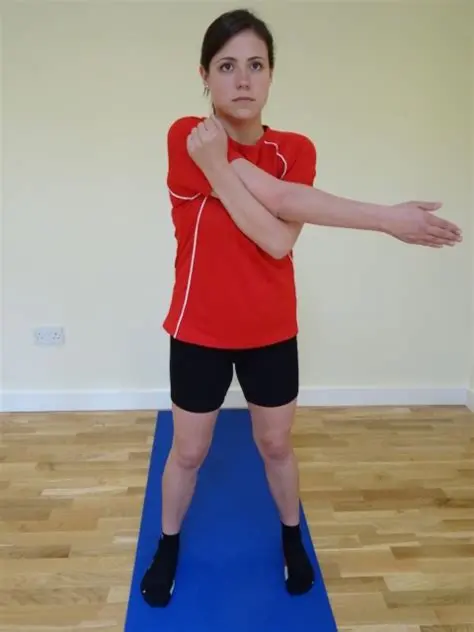
Passive Internal Rotation
Repetitions: 4 on each side
Days per week: 5 to 6 times
The patient may feel this stretch at the front of the shoulder
Equipment needed for exercise: Light stick, such as a yardstick
Step-by-step directions:
- Hold a stick behind the back with one hand, and lightly grasp the other end with the other hand.
- Pull the stick horizontally as shown so that the shoulder is passively stretched to the point of feeling a pull without pain.
- Hold the position for 30 seconds and then relax for 30 seconds.
- Repeat on the other side.
Advice: Do not lean over or twist to the side while pulling the stick.
Passive External Rotation
Repetitions: 4 on each side
Days per week: 5 to 6 times
The patient should feel this stretch in the back of the shoulder
Equipment needed for exercise: Light stick, such as a yardstick
Step-by-step directions:
- Grab the stick with one hand and cup the other end with the other hand.
- Keep the elbow of the shoulder that you are stretching against the side of the body and push the stick horizontally as shown to the point of feeling a pull without pain.
- Hold the position for 30 seconds and then relax for 30 seconds.
- Repeat the exercise on the other side.
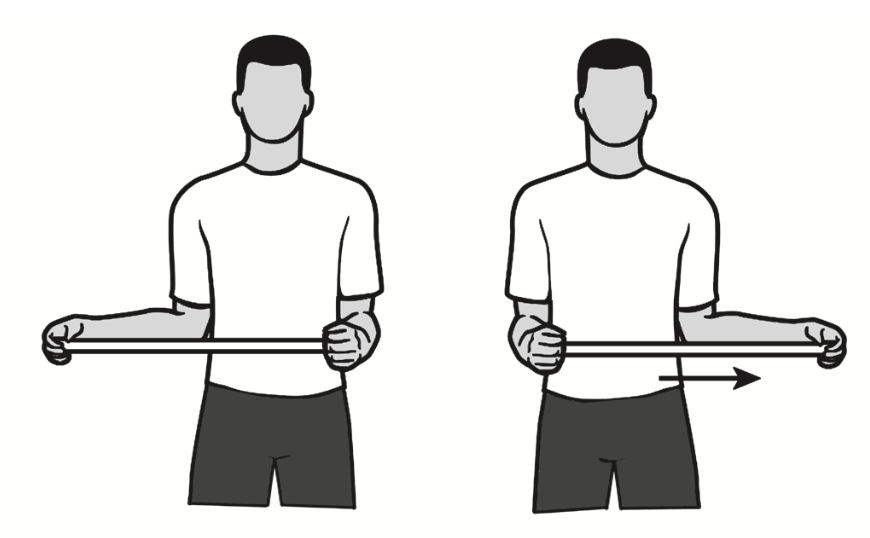
3. Strengthening:
Strengthening exercises of the shoulder can be done with resistance exercises. Various weights, Dumbbells, Elastic bands, Theraband, and manual resistance can be done.
Improve Posture: Thinking about posture, especially if a person spends long periods on a computer or smartphone can make a big difference by reducing the pressure and friction through the soft tissues in and around the shoulder. There are some really simple exercises you can do to improve posture that can make a big difference.
Summary:
Shoulder impingement syndrome occurs in the shoulder joint due to compression of the tendon. Due to this, there is inflammation in the joint. have symptoms like swelling, painful shoulder, and weakness. The patient is not able to lift their shoulder overhead. has difficulty in wearing clothes, not able to carry heavy weights. the patient may have a disturbance at night while sleeping on the affected side.
Diagnosis of pain by X-ray, MRI, ultrasound and the doctor may perform a physical examination by performing various shoulder special tests. Treatment can be medical, surgical, or physical therapy. Physical therapy plays a most important role in shoulder pain and range of movement. Physiotherapist treat by modalities and exercise including stretching, strengthening, and isometrics. Doing exercise makes the shoulder stronger and increases strength.
FAQs:
What are two signs of shoulder impingement?
The typical symptoms of shoulder impingement syndrome contain difficulty in reaching up behind the back, pain with overhead use of the arm, and weakness of shoulder muscles.
Can shoulder impingement syndrome be cured?
Shoulder impingement is rarely cured on its own, but treatment is usually very effective. Symptoms include Difficulty in reaching up behind the back and shoulder blades. Pain occurs when the arms are extended above the head, especially during overhead activities such as tennis, swimming, or baseball games.
Is shoulder impingement serious?
If the condition is left untreated, shoulder impingement can lead to more serious conditions, such as a rotator cuff tear. Physical therapists help to decrease pain and improve shoulder motion and strength in people with shoulder impingement syndrome
How long can shoulder impingement last?
Most cases of the condition will heal in three to six months, but more severe cases can take up to a year to heal.
What shoulder impingement feels like?
The main shoulder impingement syndrome (SIS) symptom is pain that occurs when the person raises his or her arms overhead or reaches backward. The pain may be at the shoulder, near the top of the arm, or down the outside of the arm, and it often happens at night or when the person lies on the affected shoulder and disturb sleep.

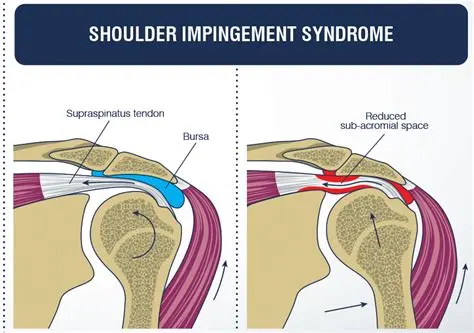
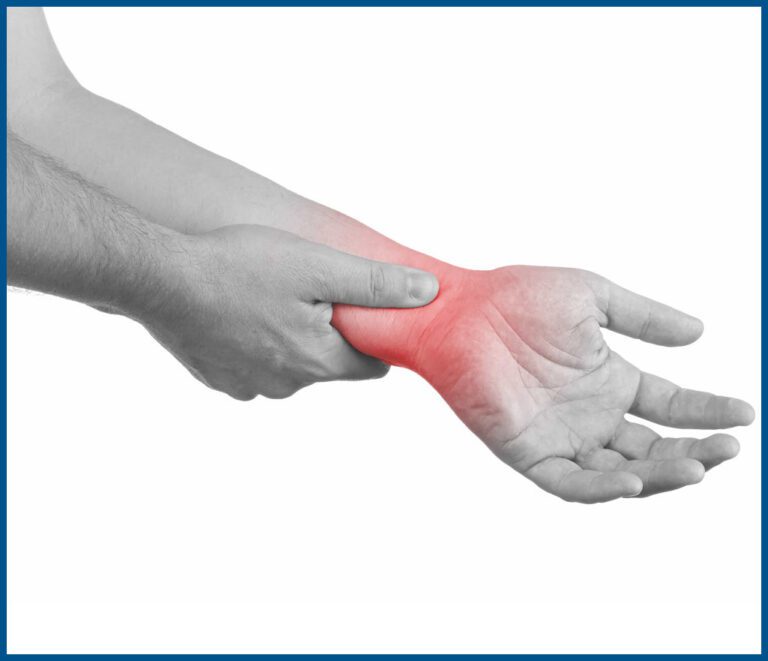

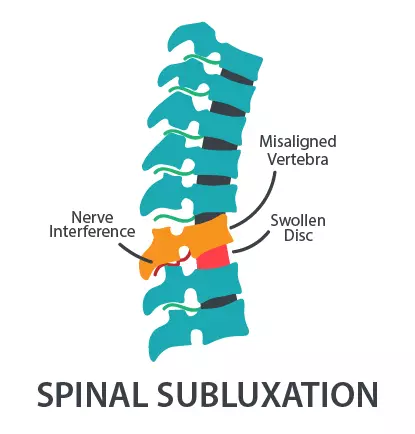
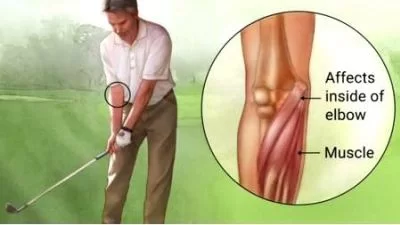
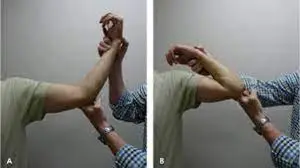
3 Comments